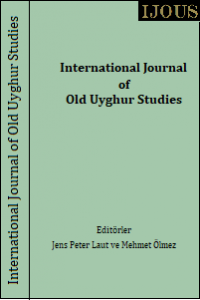Eski Uygurcadaki Resim Terminolojisi Üzerine Bir Not
Uygur duvar resimleri ve minyatürleri, ‘İpek Yolu’ ile ilgili akademik ve popüler kitaplarda en sık kopyası çıkarılan sanat eserleri arasındadır; fakat resim yapma süreciyle ilgili yazılı Eski Uygurca kaynaklar pek nadirdir. Peter Zieme tarafından 2017 yılında yayımlanmış ve 2020 senesinde makale külliyatında yeniden basılmış olan bir metinde yetenekli bir ressamın eseri bir dizi metaforla tasvir edilmiştir. Dunhuang’da bulunmuş olan Eski Uygurca el yazması, birkaç Çince teknik terimi ödünçleme sözcük şeklinde muhafaza etmiştir. Bu makale, şimdiye kadar açıklanamayan bir fiilin etimolojisini aydınlatmayı amaçlamakta ve Uygurların, bir resmin ana hatlarını çizmek için delikli şablon tekniğine aşina oldukları yorumunu önermektedir.
Anahtar Kelimeler:
Eski Uygurca, Çince, resim, delikli şablon tekniği, İpek Yolu, Orta Asya Budizmi, etimoloji, sözlük bilgisi
A Note on the terminology of painting in Old Uyghur
Uyghur murals and miniatures are among the most frequently reproduced works of art in academic and popular books on the ‘Silk Road’. However, written Old Uyghur sources about the process of painting are rare. In a text edited by Peter Zieme in 2017 and reprinted in a collection of his articles issued in 2020 the work of a skilled painter is described in a series of metaphors. The Old Uyghur manuscript found at Dunhuang preserves some Chinese technical terms in the form of loanwords. The article aims to elucidate the etymology of a hitherto unexplained verb and suggests the interpretation that the Uyghurs were familiar with the technique of pounces to sketch the outlines of a painting.
Keywords:
Old Uyghur, Chinese, painting, pounces, Silk Road, Central Asian Buddhism, etymology, lexicography,
___
- Clauson, Sir Gerard (1972): An Etymological Dictionary of Pre-Thirteenth-Century Turkish. Oxford: Clarendon Press.
- Erdal, Marcel (1991): Old Turkic Word Formation: A Functional Approach to the Lexicon. 2 vols. Wiesbaden: Harrassowitz (Turcologica 7).
- Fraser, Sarah E. (1996): Régimes of Production: The Use of Pounces in Temple Construction. In: Orientations November 1996, 60–69.
- Fraser, Sarah E. (1999): A Reconsideration of Archaeological Finds from the Turfan Region. In: 敦煌吐魯番研究 Dunhuang Tulufan yanjiu 4, 375–418.
- Fraser, Sarah E. (2000): Formulas of Creativity: Artist’s Sketches and Techniques of Copying at Dunhuang. In: Artibus Asiae LIX 3/4, 189–224.
- Grünwedel, Albert (1912): Altbuddhistische Kultstätten in Chinesisch-Turkistan: Bericht über archäologische Arbeiten von 1906 bis 1907 Kuča, Qarašahr und in der Oase Turfan. Berlin: Georg Reimer.
- Kaygusuz, Arzu (2021): Buddhistische Bildersprache in alttürkischen Texten: Eine literaturwissenschaftliche und philologische Analyse. Wiesbaden: Harrassowitz.
- Konczak, Ines (2014): Praṇidhi-Darstellungen an der Nördlichen Seidenstraße – Das Bildmotiv der Prophezeiung der Buddhaschaft Śākyamuni's in den Malereien Xinjiangs. PhD Dissertation LMU Munich.
- Kroll, Paul W. (2015): A Student’s Dictionary of Classical and Medieval Chinese. Leiden/Boston: Brill.
- Menges, Karl Henrich (1955): Glossar zu den volkskundlichen Texten aus Ost-Türkistan II. Mainz: Verlag der Akademie der Wissenschaften und der Literatur in Kommission bei Franz Steiner (Akademie der Wissenschaften und der Literatur. Abhandlungen der geistes- und sozialwissenschaftlichen Klasse 1954, 14).
- Nugteren, Hans & Jens Wilkens (forthc.): Notes on Chinese Loanwords in Old Uyghur – Thirteen Etymologies.
- Pulleyblank, Edwin G. (1991): Lexicon of Reconstructed Pronunciation in Early Middle Chinese, Late Middle Chinese, and Early Mandarin. Vancouver: UBC Press.
- Radlov, Vasilij V. & Sergej E. Malov (1913‒1917): Suvarṇaprabhāsa (sutra zolotogo bleska): Tekst ujgurskoj redakcii. Petrograd: Imperatorskaja Akademija Nauk.
- Röhrborn, Klaus (2017): Uigurisches Wörterbuch: Sprachmaterial der vorislamischen türkischen Texte aus Zentralasien – Neubearbeitung – II. Nomina – Pronomina – Partikeln. Vol. 2: aš – ažük. Stuttgart: Steiner.
- Russell-Smith, Lilla (2005): Uygur Patronage in Dunhuang: Regional Art Centres on the Northern Silk Road in the Tenth and Eleventh Century. Leiden-Boston: Brill (Brill’s Inner Asian Library 14).
- Tekin, Şinasi (1980): Buddhistische Uigurica aus der Yüan-Zeit. Wiesbaden: Harrassowitz (Asiatische Forschungen 69).
- Wilkens, Jens (2017): The Uygur translation of the Chinese Bieyi zaehanjing 別譯雜阿含經 (Hedin Collection, leaves 12–15). In: Yukiyo Kasai, Simone-Christiane Raschmann, Håkan Wahlquist & Peter Zieme (eds.), The Old Uyghur Āgama Fragments Preserved in the Hedin Collection, Stockholm. Turnhout: Brepols (Silk Road Studies 15), 197–280 (plates 23–30).
- Wilkens, Jens (2021a): Handwörterbuch des Altuigurischen: Altuigurisch ‒ Deutsch ‒ Türkisch / Eski Uygurcanın El Sözlüğü: Eski Uygurca ‒ Almanca ‒ Türkçe. Göttingen: Universitätsverlag.
- Wilkens, Jens (2021b): Uigurisches Wörterbuch. Sprachmaterial der vorislamischen türkischen Texte aus Zentralasien. III. Fremdelemente Band 1: eč ‒ bodis(a)v(a)tv. Stuttgart: Franz Steiner.
- Zieme, Peter (2017): Premières notes sur quelques fragments vieux-ouïgours de Paul Pelliot. First published on academia.edu december 2017.
- Zieme, Peter (2020): Uigurorum veterum fragmenta minora. Turnhout: Brepols (Berliner Turfantexte XLVII).
- Zieme, Peter (2022): Baumwolle und Indigo. In: Bayarma Khabtagaeva (with the assistance of Zsuzsanna Olach) (eds.), Historical Linguistics and Philology of Central Asia: Essays in Turkic and Mongolic Studies. Leiden and Boston: Brill (The Languages of Asia Series 26), 238–248.
- Yayın Aralığı: Yılda 2 Sayı
- Başlangıç: 2019
- Yayıncı: Mehmet ÖLMEZ
Sayıdaki Diğer Makaleler
Eski Uygurcadaki Resim Terminolojisi Üzerine Bir Not
Eski Uygurca İyi ve Kötü Prens Öyküsü’nde Kahramanın Yolculuğu
Jens Wilkens, Uigurisches Wörterbuch. III. Fremdelemente, Band 1
Tarihî Türk Lehçelerinden Kazakçaya Bitki Adları
Irk Bitig’de Karakuş, Kartal, Garuda Üzerine
